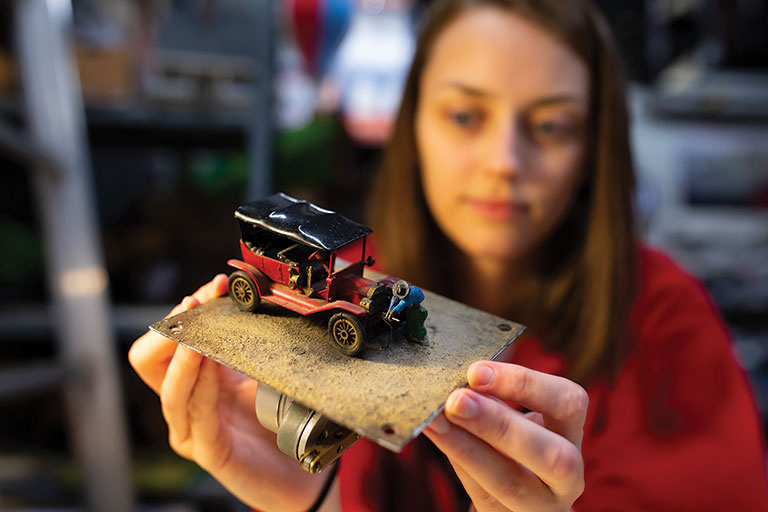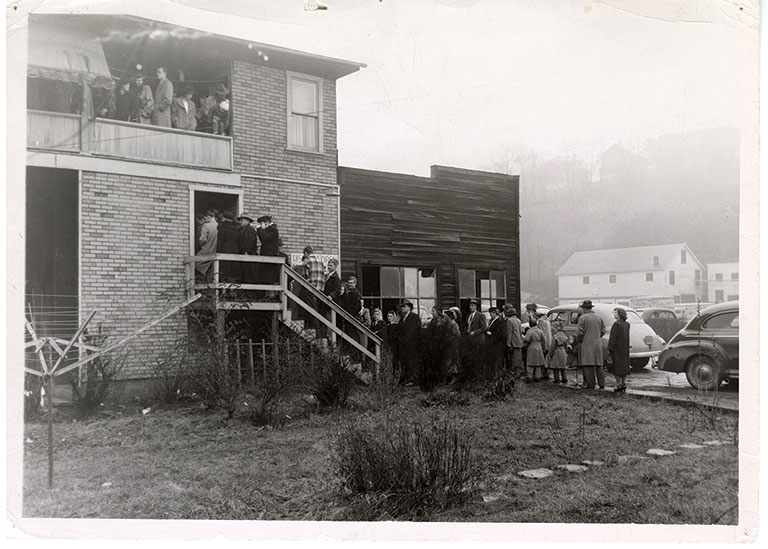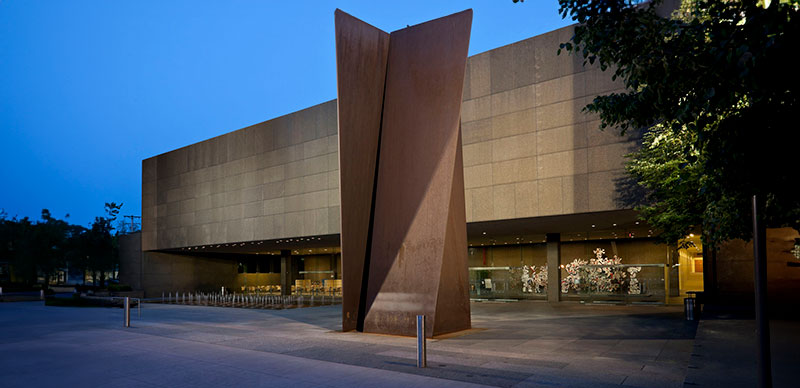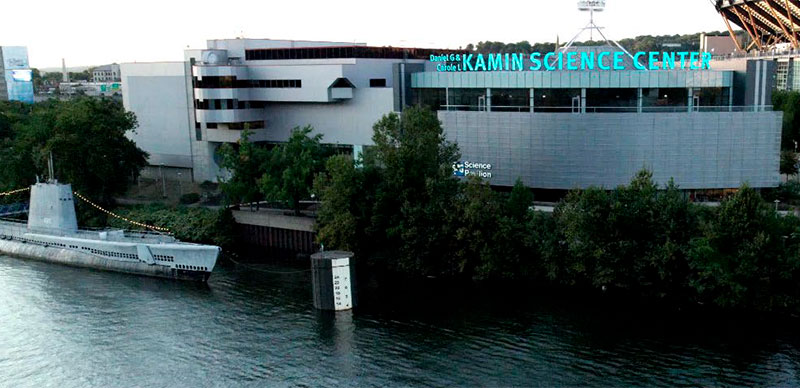Among a forest of tiny trees, a miniature man flees a miniature bear. Nearby, a mother paces inside a farmhouse, baby on her shoulder. Overhead, an acrobat stretches himself into a handstand on a pole in the middle of an amusement park.
These 3D scenes—all pint-size but amazingly lifelike—play out at Carnegie Science Center’s Miniature Railroad & Village, a small-scale world that has been a cultural touchstone for generations of Pittsburghers for nearly a century.

This model, dated to 1948, by Miniature Railroad founder Charles Bowdish was inspired by his own childhood home. Seated in a rocker on the porch are models of his mother and older brother, Stean.
The 83-foot-by-30-foot display turns 100 later this year, and for its legions of fans it’s been a place of constant discovery. No detail is too small.
For decades, visitors making their way around the large, rectangular platform have seen a woman rocking her child on a porch. Less obvious is the cat sprawled out, its tail flipping under the chair. Just before the rocker comes down again, the cat whips its tail out of harm’s way.
Across the length of the exhibit, in a scene of freshly fallen snow, a man relieving himself in an outhouse is reading an itsy-bitsy Sears catalog, something only an eagle-eyed observer could spy as the latrine door swings open ever so briefly.
“The closer you look and the more you visit, the more you discover.”
– Patty Everly, the Science Center’s curator of historic exhibits


These slice-of-life details come alive through 105 animations, each powered by their own miniature motors. In one scene a man is chopping wood, in another a man washes his back with a brush in an outdoor bathtub. At the miniature Forbes Field, two motors, cranks, cams, and bevel gears give the batter’s swing its natural look.
“The closer you look and the more you visit, the more you discover,” says Patty Everly, the Science Center’s curator of historic exhibits and the display’s creative caretaker since 1991. “No matter how often people visit, they find things that they think are new, but most times they just didn’t notice them before. There is a lot to see.”
Telling history in miniature
It helps that for two months each fall, in addition to adding a new model, Everly and her small team of mostly part-time staff and volunteers clean and give a facelift to the scenes that capture the spirit of western Pennsylvania from the 1880s through the late 1930s—all in miniature. Things—large and small—are, in fact, constantly changing.
Recently, the team refreshed the rolling hills of the countryside. On one farm, pigs escape their pen. In another sprawling scene is a reconstruction of Manchester Farm in Avella, which dates to 1815. “That goat standing on the stone wall,” explains Everly, “I saw one just like it when I was there photographing the farm, and we wanted to include that level of real detail. It’s been a continuously active farm,” she continues, “and owned and lived in by the same family for the last 200 years. It’s an amazing piece of history.”

Nearby, visitors can now peek inside the windows at the hustle and bustle of a miniature general store, blacksmith shop, and other 20th-century Main Street businesses built by the exhibit’s founder, Charles Bowdish. By moving the models closer to the edge of the display and adding interior lights, that corner of the exhibit—not far from where kids can step up and blow the train whistle—now draws more oohs, aahs, and eager finger pointing, especially from pint-size onlookers who have the perfect vantage point.
Outside of the model of the church where Bowdish’s parents were married, Everly has created a scene where a husband and wife, greeted by family and friends, spill out of the church. The special moment is tucked away on a side street and can be easy to miss. Discovering it is a little like finding hidden treasure. And people do notice, says Nicole Wilhelm, the exhibit’s full-time program assistant. At one time, the church included a cemetery instead. “People still ask about it,” says Wilhelm. “Visitors definitely have their favorite moments and scenes.”

In 2016, when Everly built her first model by way of 3D printing, she also ushered the exhibit into the nuclear age with the addition of Westinghouse Electric’s atom smasher. The bulb-shaped replica of the Van de Graaff accelerator duplicates a distinct part of the Forest Hills skyline, circa 1937. On either side of this unique piece, she placed a pair of lesser-known, not-to-be-missed additions: a 1938 billboard for the American Bantam Car Co., the Butler, Pennsylvania, maker of what became the Jeep, and the Rudy Bros. Co. Stained Glass building. Peer inside the glasshouse—replicated in the spirit of the scores of glasshouses that once lined Pittsburgh’s South Side neighborhood—for a glimpse into the region’s first industry, and one that once earned the city the moniker America’s Glass City.
Everly goes to great lengths to make what’s believed to be the oldest model train display in the country as accurate and lifelike as possible. Part historian, part artist, and part architect, she built the outfield wall of the miniature version of Forbes Field from a ground-up brick salvaged from the real thing. She used chunks of sandstone to create the outer walls of the stunning replica of Frank Lloyd Wright’s Fallingwater, a mammoth challenge that took her five months to complete. Everly says she didn’t want to use commercial model builder or modeling stone because it was too even and artificial-looking. The solution came one day when she was walking around her old farmhouse in Cecil Township. Everly noticed that the big flat sandstone on her sidewalk was peeling. With a putty knife, she flicked off the thin layers of rock and cut them into strips that would form the Fallingwater’s stonework.
“Patty’s a rock star,” Wilhelm says of Everly. “She is so talented!”
With a master’s degree in public history, Wilhelm, a Lancaster native, was drawn to the historic roots of the exhibit. But she admittedly has a lot more to learn about the artistic side of the job, a specialty of Everly’s, who grew up in a rural landscape of farmhouses and a railroad that crossed in front of her own driveway, inspiring her art from a young age.

Nicole Wilhelm, holding one of the Miniature Railroad’s 105 animated parts. Beneath its base is its own tiny motor.
Even the Miniature Railroad’s murky river reflects the real world. While the water that flows through the exhibit, about three inches deep, comes out of the faucet, Everly made sure to paint the basin a custom hue so it matches the actual color of the Ohio River, Wilhelm says.
“It’s adding shadow, texture, and depth that makes the scenes look so realistic,” Wilhelm continues, pointing to the rolling hills of the countryside as the light bounces off of the green pasture. “There’s a lot to the artistic side of the display. I’m still learning that part of it, and Patty is an amazing teacher.”
Going willingly down the rabbit hole
Everly also has research chops. The newest series of models, added in 2018, is a collection of seven homes (one still under construction) known as Cement City, a worker housing complex in Donora, Pennsylvania, designed by Thomas Edison (yes, that Thomas Edison). Edison wanted to eliminate slum-like conditions and create safe, affordable homes for poorer workers. “He wanted to make it attractive to give the workers dignity,” explains Everly. “But it was a failure. He never did reduce the costs of building a frame house.”

The cement houses were painted in multi-colored pastel shades, an unusual choice for that era, and Everly, always the perfectionist, wanted to get the colors just right. Historical records referenced a color called “Chevy Chase” for at least one of the homes. So she called Harvard University’s pigment library, which keeps the largest collection of rare and historic pigments in the world, but even they didn’t know. “I called people around the globe. My staff thought it was comical how far I went down a rabbit hole.” She never found the exact hue, but she painted the houses as they are listed in historic records: cream, buff, slate gray, and she chose a green for Chevy Chase.
Everly and her team first selected five of the original floor plans from blueprints on loan from the Donora Historical Society and Smog Museum to reproduce the houses’ structures.
Exhibit technician Andrew Spate then added prairie-style pitched roofs, arts-and-crafts windows, porches, and trellises to flesh out the era’s aesthetic. And Everly applied the acrylic paint with a sand base to replicate the cement texture of the houses’ walls. To really set the scene: out front a block party is in full swing.
“Over the decades, we realized that we could use this superpower for good—we could entertain and educate, and we became laser-focused on a mission to tell the big story of Pittsburgh and our region and its place in history.”
– Patty Everly
To recreate the suffragette parade that marched along Grant Street in downtown Pittsburgh on May 2, 1914, Everly (who worked on the project with volunteer Charlene Beck) dug up the microfilm at Carnegie Library of Pittsburgh and supervised an intern who conducted additional research supported by a grant from the Pennsylvania Humanities Council.
The lead car in the parade, driven by Jennie Bradley Roessing, pulls a tiny float with a model of the Liberty Bell and a sign that reads, “This Liberty Bell will not ring until women win the right to vote.” Roessing drove the car to each of Pennsylvania’s 67 counties as she fought for the 19th Amendment.

The suffragette parade, modeled after the actual parade on Grant Street on May 2, 1914.
A visitor pointing to the suffragette parade might also be lucky enough to get an extra history lesson from Bob Tinkham, a part-time presenter at the Miniature Railroad and a fast friend to curious visitors. Sometimes he tells a story about Mary Flinn Lawrence, a prominent suffragette who marched in the same parade. “She got tired of carrying the banner, so her husband carried it,” says Tinkham. “People on the sidewalk started laughing.” Her husband figured out why there was laughter when he looked down at the sign. “It said, ‘If a man can vote, why can’t I?’”
For Everly and team, the smallest of details, the personal accounts—they’re all part of bringing to light the region’s past.
“Over the decades, we realized that we could use this superpower for good—we could entertain and educate, and we became laser-focused on a mission to tell the big story of Pittsburgh and our region and its place in history, how we influenced and impacted the country and the world,” Everly says, “especially when it came to technology, engineering, and innovation.”
Past meets present
Charles Bowdish didn’t have today’s technologies at his fingertips when he started what would become the Miniature Railroad & Village a century ago in his home in Brookville, Pennsylvania. What he did have was an artist’s eye, a master craftsman’s skill, and a storyteller’s flair for captivating an audience.
He was the best man in his brother’s wedding, and after the ceremony Bowdish invited guests to his home, where he had built a model of Brookville’s Main Street in his living room as a means of entertainment. One guest asked if he could bring his friends by later, and by the end of the day 600 people had tramped through the house.

By 1954, more than 300,000 people had visited Bowdish’s Brookville home to view his miniature display.
As Bowdish added new models to his display, people from all over the country descended on the tiny town of Brookville. By 1954, more than 300,000 people had visited his house to see the expanding and intricate little world. Look closely at today’s version to find a model of the home where he displayed his creation—with a line of people snaking up its front steps waiting to enter.
Among Bowdish’s more well-known contributions: that woman walking back and forth in a lit room as she rocks her baby. It turns out that this model home was inspired by his own childhood home, complete with his mom rocking his older brother to sleep on the porch.
He also created a crowd favorite—“handstand man,” the death-defying acrobat who does a handstand on a pole high above a turn-of-the-century amusement park, a composite of Kennywood, the old Luna Park in North Oakland, and Lakemont Park in Altoona. “Charlie designed it in his living room,” Bob Tinkham says of the acrobatic animation. “We have his drawing on how he did it.”
The pole is high above a model of Leap the Dips, the oldest wooden roller coaster in the world, built in 1902 in Lakemont Park. On one of his days off from giving Miniature Railroad tours, Tinkham went to Altoona and rode the old-time roller coaster. As he shares this bit of history with Science Center visitors, he takes off his hat to show the “I rode the world’s oldest wooden roller coaster” ticket taped to the inside.

Among Charles Bowdish’s crowd favorites: an acrobat that manages to accomplish a handstand high above the Miniature Railroad’s amusement park
Then there are the personal stories of visitors. A couple of years ago, Everly and team invited a community group from the Hill District to view the model of the Crawford Grill. Everly had researched old photographs and records of the famous jazz club as inspiration for the model. A tiny red-and-white poster in the window advertises a boxing match of Billy Conn, and a tiny version of famed photojournalist Charles “Teenie” Harris stands snapping a picture of men unloading a sparkly new piano for the jazz club.
As part of the sneak peek, they showed the group a 1947 photo taken by Harris.
“That’s me in the hat!” exclaimed Dorothy Slater, now in her 80s, who at the time the photograph was taken was celebrating her 18th birthday with her mother and other relatives.
“I was wearing that bright green dress and I thought I was hot stuff,” Tinkham recalls her saying. Slater shared her memories of the jazz club, where greats like Duke Ellington, Billy Strayhorn, and Louis Armstrong played. Then she gave Everly and her staff the highest compliment: “You got it just right.”

About a year ago, Everly received a phone call from a man who said his friend had made something for her.
What could it be, she wondered?
The man in his 60s arrived with friends and handed Everly a box with tissue paper wrapped around three tiny trees, each one with an eagle’s nest in it. He explained that, as a 6-year-old boy, he had stolen one of the trees so he could take it home and figure out how they made it—which he did—but he always felt guilty about it. So he wanted to make amends five decades later.
Everly joked with the man that they were going to frisk him on the way out the door. “They were delightful,” she says, noting that she added one of the man’s trees to the display.
[URIS id=7469]
As Carnegie Museums celebrates 100 years of the Miniature Railroad & Village, help us keep it on track for another 100 years! Give today or call 412.622.3314.







